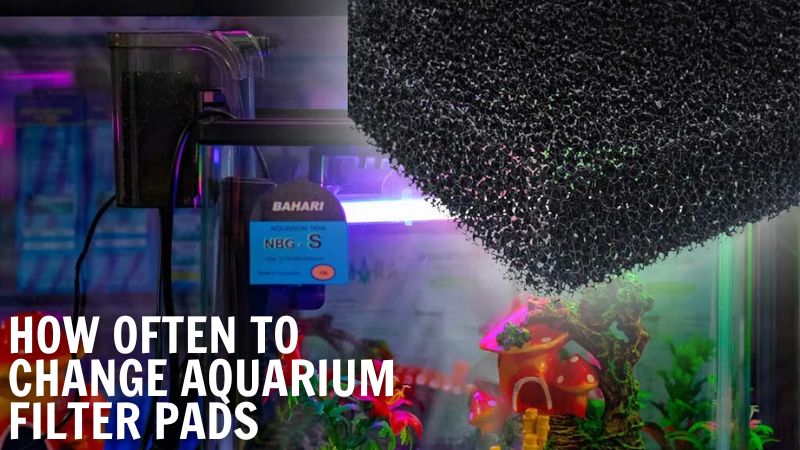Aquarium filter pads play a crucial role in maintaining a healthy environment for your fish. They trap debris and waste, preventing it from circulating back into the tank. However, these pads can become clogged over time, hindering water flow and reducing their effectiveness. The question then becomes: how often should you change your aquarium filter pads? Let’s join Tropical Fish Haven to find the answer to the question of how often to change aquarium filter pads.
Reasons to periodically replace water filter materials
In fact, the lifespan of filter materials will depend on the quality of the input water source. If you use water filters with many typical impurities such as drilled well water, their lifespan will be significantly reduced.
Replacing filter materials in industrial water filtration systems will bring many benefits such as:
- Helps ensure water filtration efficiency for the entire system: The filter material is a pre-filter system that helps remove large pollutants, helping the fine filter membrane not to become clogged, thereby ensuring filtration performance.
- Helps save costs: Replacing filter materials helps ensure water filtration performance, avoiding wasting energy. Besides, they also help protect the fine filter membrane, ensuring filter life. According to calculations, the replacement cost of this type of filter material is much cheaper than that of fine filter membranes. From there, it helps save costs on the repair and replacement of filter membranes.
Signs that the filter material needs to be replaced
Replacing filter material is a must if you want the water filtration system to operate effectively and smoothly. Below are typical signs that indicate the need to replace water filter materials.
The filter material has an unpleasant odor
Filter material helps remove dirt, mud, chemicals,… mixed in water. During the filtration process, these impurities will stick to the filter material, causing it to gradually lose its function. When you notice that the filter water has an unpleasant odor, it is best to have a plan to replace it.
The filter material is no longer as effective as it was before
When you realize that the output water quality is no longer of the original quality, the system’s filtration capacity is reduced compared to the design, and the amount of water discharged is large, you need to consider replacing the loc material.
Filter materials used beyond their useful life will affect the quality of the water source, so they need to be replaced to ensure it.
How often to change aquarium filter pads?
Changing aquarium filter pads depends on several factors including the type of filter, the amount of waste in the tank, and the specific manufacturer’s recommendations. Here’s a general guideline to help you decide how often to change aquarium filter pads:
Mechanical Filter Pads
- Purpose: Mechanical filter pads trap solid debris and particles from the water.
- Frequency: Mechanical filter pads should be checked regularly, typically every 2-4 weeks.
- Indicators: Change them when they appear clogged or dirty, reducing water flow through the filter.
Chemical Filter Media
- Purpose: Chemical filter media such as activated carbon or zeolite absorb impurities and odors.
- Frequency: Activated carbon should generally be replaced every 3-4 weeks, while other chemical media like zeolite may last longer (up to 2-3 months) depending on the brand and usage.
- Indicators: Change when the media loses its effectiveness or if there are noticeable changes in water quality.
Biological Filter Media
- Purpose: Biological filter media (like ceramic rings, bio-balls, or sponges) host beneficial bacteria that break down ammonia and nitrite.
- Frequency: Biological media should not need frequent replacement as they primarily need rinsing in old tank water to remove debris.
- Indicators: Replace only if the media deteriorates or becomes clogged beyond cleaning.
Factors Influencing Filter Pad Changes
- Tank Size and Stocking: Larger tanks with more fish produce more waste, necessitating more frequent changes.
- Type of Fish: Fish species that produce more waste or are messy eaters may require more frequent changes.
- Filter Type: Different filters (hang-on-back, canister, internal, etc.) have varying capacities and efficiencies, affecting how often pads need changing.
- Water Quality: Regular testing for ammonia, nitrite, nitrate, and pH levels can indicate when filter maintenance is needed.
Tips for Maintaining Filter Pads
- Regular Inspections: Check filter pads weekly for buildup and replace them as needed.
- Partial Replacements: Consider rotating filter pads so that not all are replaced at once, maintaining a portion of beneficial bacteria.
- Clean Water for Rinsing: Rinse mechanical filter pads in dechlorinated water from the tank to avoid killing beneficial bacteria.
- Follow Manufacturer Recommendations: Refer to the filter manufacturer’s guidelines for specific recommendations on maintenance and replacement.
By following these guidelines and adapting them based on your specific tank conditions, you can ensure that your aquarium filter pads effectively maintain water quality and support a healthy aquatic environment for your fish.
Usage time of some typical filter materials
Each type of filter material will have a different lifespan, but the average will be from 6 to 12 months. Join Song Giang to review the lifespan of popular filter materials.
Quartz sand
Quartz sand is a material mined from nature with the ability to remove impurities, heavy metals, ephemera, mud, etc. Quartz sand usually has a fairly long lifespan. However, in well water filtration systems, quartz sand should be replaced periodically from 6 to 12 months to ensure water quality.
Quartz pebbles
Quartz pebbles are large in size, uneven and shiny. This material is often combined with quartz sand, and manganese sand,… and plays a supporting role, in improving crude filter performance. Quartz gravel lifespan is 6 to 12 months and will also vary depending on water quality.
Activated carbon
Activated carbon has the ability to deodorize, impurities and remove heavy metals in water. This type has a large surface size, is light, and has a porous molecular structure.
According to the supplier, activated carbon has a lifespan of 6 to 9 months. However, if the water is heavily polluted or contaminated with alum, their lifespan can be shortened to less than 6 months.
Cation resin
This type of material is often used in water-softening systems, Through the ion exchange process, water hardness is reduced. The lifespan of the cation beads will be 6 to 12 months. However, when you notice that the seeds have turned darker in color, they should be replaced to ensure filtration efficiency.
Conclusion
Maintaining clean filter pads is essential for optimal water quality and a thriving aquarium. By considering factors like bioload, tank size, and pad type, you can establish a regular cleaning routine that keeps your filter functioning efficiently. Remember, a gentle rinse in tank water is often preferable to complete replacements, as you want to preserve the beneficial bacteria colonizing the pads. With consistent monitoring and proper care, your filter pads will continue to keep your aquarium sparkling clean and your fish happy and healthy.





